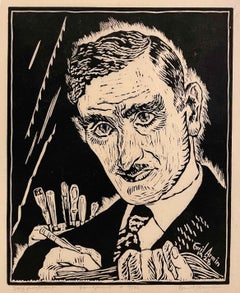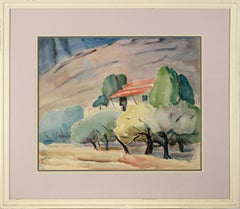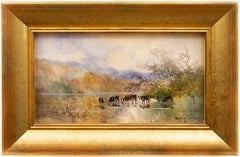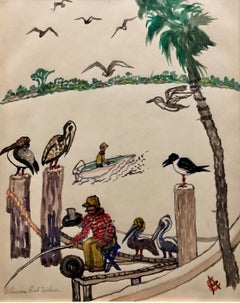Emil Armin Art
to
2
2
2
1
A 1928 Woodcut on Paper, Self-Portrait of Notable Chicago Modernist Emil Armin
By Emil Armin
Located in Chicago, IL
A 1928 woodcut on paper of a self-portrait of Notable Chicago Modernist artist Emil Armin. artowrk size: 10 1/2" x 8". Archivally matted to: 12 1/2" x 14 1/2. Edition 7/30.
Emil Armin was born in Radautz, Austria in 1883. By the age of 10, Armin was orphaned and was raised by his older siblings. He supported himself by working in restaurants and drew in his spare time. In 1905, at the age of 21, Armin immigrated to Chicago. He began studying at the Art Institute of Chicago in 1907, but financial difficulties forced him to start and stop a number of times, finally graduating in 1920. He studied with George Bellows and Randall Davey. Armin was an integral part of Chicago’s 57th Street Art Colony and exhibited in both the more avant-garde Chicago No-Jury Society Shows, as well as the more formal and conventional Chicago Society of Artists Exhibitions, the Chicago Renaissance Society and Art Institute of Chicago (1922-1949) exhibitions. He taught at Hull House...
Category
1920s American Modern Emil Armin Art
Materials
Paper, Woodcut
House on the Hillside in the Trees - Watercolor on Paper
By Emil Armin
Located in Soquel, CA
Boldly colored watercolor landscape by Emil Armin (American/Rumanian, 1882-1972). A house with a bright red roof is nestled between some trees at the bottom of a hillside. The trees are depicted as large, voluminous shapes, giving them a solid presence in the composition.
Signed "E. Armin '11" in the lower left corner.
Presented in a wood frame with a mat.
Frame size: 29"H x 33"W
Image size: 18.75"H x 22.5"W
Born in Rumania on April 1, 1883, Emil Armin studied at the School of the Art Institute of Chicago's evening classes under Dudley Crafts Watson, Randall Davey and George Bellows, then he graduated in 1920. Between 1922 and 1949 he exhibited his works at the Art Institute annuals and was involved in the No-Jury Society, organized in 1922. At that time he was immersed in Chicago's bohemian 57th Street Art Colony and he experimented with sculpture and decorative arts as a member of the Chicago Society of Artists. He taught at Chicago's Hull House (1925-26) and did cartoons full of angular forms and a particular method of shading and "zigzag outlining" taken from German Expressionist masters, for the Chicago Literary Times, a journal created by Maxwell Bodenheim and Ben Hecht. Samuel Putnam, a critic for the Chicago Evening Post (21 September 1926) regarded Armin as "perhaps the most finely sensitized artist in Chicago . . . with the soul of a peasant and the mind of a philosopher."
In 1928 Armin traveled to New Mexico where he executed a naïve, child-like woodcut, Mountain Farm, Santa Fe (Art Institute). Chicago critic Bulliet's characterization of Armin as a "primitive" in impulses, "though sophisticated and intelligent" applies here: "His work resembles somewhat the peasant art...
Category
Early 20th Century American Impressionist Emil Armin Art
Materials
Paper, Watercolor
Related Items
Landscape View With Cows Drinking Water by American Artist Hugo Anton Fisher
Located in Stockholm, SE
We are delighted to offer a captivating watercolor by the American artist Hugo Anton Fisher (1854–1916). This serene composition depicts cows drinking at the edge of a calm body of w...
Category
Late 19th Century American Impressionist Emil Armin Art
Materials
Paper, Watercolor
"Canal at Indian Mound Road" RARE Ben Fenske Gouache work on paper black & white
By Ben Fenske
Located in Sag Harbor, NY
Painted during the 2015 Winter Equestrian Festival in Wellington, Florida. A black and white depiction of a canal, is barely recognizable, due to Fenske's wild brushstrokes and lack...
Category
21st Century and Contemporary American Impressionist Emil Armin Art
Materials
Paper, Gouache
Cypriano (A Basque Boy)
By Gerald Leslie Brockhurst
Located in Middletown, NY
Etching on cream wove paper. 6 5/16 x 3 3/4 inches (159 x 94 mm), full margin. Signed in pencil lower center margin, from the edition of 111. A well inked impression with a minor cre...
Category
Mid-20th Century American Modern Emil Armin Art
Materials
Handmade Paper, Etching
"Untitled 1, " Watercolor Painting
Located in Denver, CO
Clyde Steadman's "Untitled 1" is an original, handmade watercolor painting that depicts an urban landscape with human silhouettes.
Category
2010s American Impressionist Emil Armin Art
Materials
Watercolor, Paper
'Verdi' — American Modernism - Italian Opera Composer
By Paul Landacre
Located in Myrtle Beach, SC
Paul Landacre, 'Verdi', wood engraving, 1936, edition 60, (only 14 printed), Wien 188. Signed, titled, and numbered '10/60' in pencil. A fine impression, on cream, laid Japan paper, ...
Category
1930s American Modern Emil Armin Art
Materials
Woodcut
"Train Station, " Max Kuehne, Industrial City Scene, American Impressionism
By Max Kuehne
Located in New York, NY
Max Kuehne (1880 - 1968)
Train Station, circa 1910
Watercolor on paper
8 1/4 x 10 1/4 inches
Signed lower right
Provenance:
Private Collection, Illinois
Max Kuehne was born in Halle, Germany on November 7, 1880. During his adolescence the family immigrated to America and settled in Flushing, New York. As a young man, Max was active in rowing events, bicycle racing, swimming and sailing. After experimenting with various occupations, Kuehne decided to study art, which led him to William Merritt Chase's famous school in New York; he was trained by Chase himself, then by Kenneth Hayes Miller. Chase was at the peak of his career, and his portraits were especially in demand. Kuehne would have profited from Chase's invaluable lessons in technique, as well as his inspirational personality. Miller, only four years older than Kuehne, was another of the many artists to benefit from Chase's teachings. Even though Miller still would have been under the spell of Chase upon Kuehne's arrival, he was already experimenting with an aestheticism that went beyond Chase's realism and virtuosity of the brush. Later Miller developed a style dependent upon volumetric figures that recall Italian Renaissance prototypes.
Kuehne moved from Miller to Robert Henri in 1909. Rockwell Kent, who also studied under Chase, Miller, and Henri, expressed what he felt were their respective contributions: "As Chase had taught us to use our eyes, and Henri to enlist our hearts, Miller called on us to use our heads." (Rockwell Kent, It's Me O Lord: The Autobiography of Rockwell Kent. New York: Dodd, Mead and Co., 1955, p. 83). Henri prompted Kuehne to search out the unvarnished realities of urban living; a notable portion of Henri's stylistic formula was incorporated into his work.
Having received such a thorough foundation in art, Kuehne spent a year in Europe's major art museums to study techniques of the old masters. His son Richard named Ernest Lawson as one of Max Kuehne's European traveling companions. In 1911 Kuehne moved to New York where he maintained a studio and painted everyday scenes around him, using the rather Manet-like, dark palette of Henri.
A trip to Gloucester during the following summer engendered a brighter palette. In the words of Gallatin (1924, p. 60), during that summer Kuehne "executed some of his most successful pictures, paintings full of sunlight . . . revealing the fact that he was becoming a colorist of considerable distinction." Kuehne was away in England the year of the Armory Show (1913), where he worked on powerful, painterly seascapes on the rocky shores of Cornwall. Possibly inspired by Henri - who had discovered Madrid in 1900 then took classes there in 1906, 1908 and 1912 - Kuehne visited Spain in 1914; in all, he would spend three years there, maintaining a studio in Granada. He developed his own impressionism and a greater simplicity while in Spain, under the influence of the brilliant Mediterranean light. George Bellows convinced Kuehne to spend the summer of 1919 in Rockport, Maine (near Camden). The influence of Bellows was more than casual; he would have intensified Kuehne's commitment to paint life "in the raw" around him.
After another brief trip to Spain in 1920, Kuehne went to the other Rockport (Cape Ann, Massachusetts) where he was accepted as a member of the vigorous art colony, spearheaded by Aldro T. Hibbard. Rockport's picturesque ambiance fulfilled the needs of an artist-sailor: as a writer in the Gloucester Daily Times explained, "Max Kuehne came to Rockport to paint, but he stayed to sail." The 1920s was a boom decade for Cape Ann, as it was for the rest of the nation. Kuehne's studio in Rockport was formerly occupied by Jonas Lie.
Kuehne spent the summer of 1923 in Paris, where in July, André Breton started a brawl as the curtain went up on a play by his rival Tristan Tzara; the event signified the demise of the Dada movement. Kuehne could not relate to this avant-garde art but was apparently influenced by more traditional painters — the Fauves, Nabis, and painters such as Bonnard. Gallatin perceived a looser handling and more brilliant color in the pictures Kuehne brought back to the States in the fall. In 1926, Kuehne won the First Honorable Mention at the Carnegie Institute, and he re-exhibited there, for example, in 1937 (Before the Wind). Besides painting, Kuehne did sculpture, decorative screens, and furniture work with carved and gilded molding. In addition, he designed and carved his own frames, and John Taylor Adams encouraged Kuehne to execute etchings. Through his talents in all these media he was able to survive the Depression, and during the 1940s and 1950s these activities almost eclipsed his easel painting. In later years, Kuehne's landscapes and still-lifes show the influence of Cézanne and Bonnard, and his style changed radically.
Max Kuehne died in 1968. He exhibited his work at the National Academy of Design, the Art Institute of Chicago, the Carnegie Institute in Pittsburgh, the Memorial Art Gallery of the University of Rochester, and in various New York City galleries. Kuehne's works are in the following public collections: the Detroit Institute of Arts (Marine Headland), the Whitney Museum (Diamond Hill...
Category
1910s American Impressionist Emil Armin Art
Materials
Paper, Watercolor
"Monhegan Island, Maine, " Edward Dufner, American Impressionism Landscape View
By Edward Dufner
Located in New York, NY
Edward Dufner (1872 - 1957)
Monhegan Island, Maine
Watercolor on paper
Sight 16 x 20 inches
Signed lower right
With a long-time career as an art teacher and painter of both 'light' and 'dark', Edward Dufner was one of the first students of the Buffalo Fine Arts Academy to earn an Albright Scholarship to study painting in New York. In Buffalo, he had exchanged odd job work for drawing lessons from architect Charles Sumner. He also earned money as an illustrator of a German-language newspaper, and in 1890 took lessons from George Bridgman at the Buffalo Fine Arts Academy.
In 1893, using his scholarship, Dufner moved to Manhattan and enrolled at the Art Students League where he studied with Henry Siddons Mowbray, figure painter and muralist. He also did illustration work for Life, Harper's and Scribner's magazines.
Five years later, in 1898, Dufner went to Paris where he studied at the Academy Julian with Jean-Paul Laurens and privately with James McNeill Whistler. Verification of this relationship, which has been debated by art scholars, comes from researcher Nancy Turk who located at the Smithsonian Institution two 1927 interviews given by Dufner. Turk wrote that Dufner "talks in detail about Whistler, about how he prepared his canvasas and about numerous pieces he painted. . . A great read, the interview puts to bed" the ongoing confusion about whether or not he studied with Whistler.
During his time in France, Dufner summered in the south at Le Pouleu with artists Richard Emil Miller...
Category
Early 20th Century American Impressionist Emil Armin Art
Materials
Watercolor, Paper
Searching the Waters
By Lu Haskew
Located in Loveland, CO
Searching the Waters by Lu Haskew
Pastel 18x22" image size, 26x30" framed
Figurative Portrait of young children on a dock looking into the water.
ABOUT THE ARTIST: Lu Haskew 1921...
Category
1990s American Impressionist Emil Armin Art
Materials
Watercolor
Bibi Valentin
By James Abbott McNeill Whistler
Located in Storrs, CT
Bibi Valentin. 1859. Etching and drypoint. Kennedy catalog 50 state ii; Glasgow catalog 34 state ii. 6 x 8 7/8 (sheet 8 11/16 x 10 11/16). Glasgow records 44 known impressions. A rich impression with burr, printed on watermarked laid paper with full margins. Signed and dated in the plate. Housed in a 20 x 16-inch archival mat
A young girl, sits facing the viewer, leaning on her left elbow, legs extended to left. She wears a high-necked smock and buttoned boots...
Category
19th Century American Modern Emil Armin Art
Materials
Drypoint, Etching
'Moss Beach, Monterey, California', Pacific Coastal Landscape, ASL NYC, Benezit
By Elmer Wachtel
Located in Santa Cruz, CA
An early-20th-century, landscape showing a view of the coastline at Moss Beach in Monterey County with slate-blue skies overhead and a view towards a stand ...
Category
Early 1900s American Impressionist Emil Armin Art
Materials
Paper, Watercolor, Gouache
Will Barnet Early Important Figural B&W Etching American 1940 Framed Rare
By Will Barnet
Located in Buffalo, NY
A nice rare early etching by the noted American Artist Will Barnet titled "Mary", created in 1936.
Category
1930s American Modern Emil Armin Art
Materials
Paper, Etching
"MAROON BELLS" ASPEN COLORADO MOUNTAINS
Located in San Antonio, TX
Edward Lee Reichert
(1919-2011)
Texas Artist
Image Size: 12 x 18
Frame Size: 21 x 27
Medium: Watercolor
Dated 2005
"Maroon Bells" Aspen CO
Biography
Edward Lee Reichert (1919-2011)
E...
Category
Early 2000s American Impressionist Emil Armin Art
Materials
Watercolor
Previously Available Items
Pelicans and Fisherman Watercolor Painting Chicago WPA Artist
By Emil Armin
Located in Surfside, FL
Image is 14 X 11 and then matted. It is signed and dated and inscribed R.H. Love gallery.
EMIL ARMIN was born in Radautz, Roumania, in 1883 to a devoutly religious Jewish family. His grandfather was a sopher a scribe of ritual scrolls. He studied at the Art Institute of Chicago. His formative teachers were George Bellows, Randall Davey and Herman Sachs. He has painted in
Maine, Ohio and New Mexico and exhibited in both the avant-garde Chicago No-Jury Society Shows, as well as the Chicago Society of Artists Exhibitions, the Chicago Renaissance Society and Art Institute of Chicago (1922-1949) exhibitions. He is a member of the Chicago Society
of Artists, Chicago No-Jury Society of Artists and 10 Artists (Chicago). Works of his have been exhibited throughout the United States. He has had one-artist exhibitions at the Art Institute of Chicago and other local public places. His work has been included in many prestigious shows, hanging alongside the masters including at the Renaissance society in MAR 8–MAR 24, 1955
in the show AS THEY LIKE IT Gertrude Abercrombie...
Category
1960s American Modern Emil Armin Art
Materials
Paper, Watercolor
Emil Armin art for sale on 1stDibs.
Find a wide variety of authentic Emil Armin art available for sale on 1stDibs. You can also browse by medium to find art by Emil Armin in paint, paper, watercolor and more. Much of the original work by this artist or collective was created during the 20th century and is mostly associated with the Impressionist style. Not every interior allows for large Emil Armin art, so small editions measuring 33 inches across are available. Customers who are interested in this artist might also find the work of Joseph Yeager, Laurence Sisson, and Eve Nethercott. Emil Armin art prices can differ depending upon medium, time period and other attributes. On 1stDibs, the price for these items starts at $1,080 and tops out at $1,080, while the average work can sell for $1,080.



